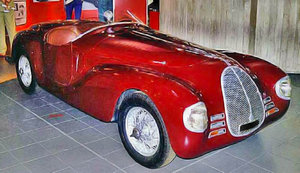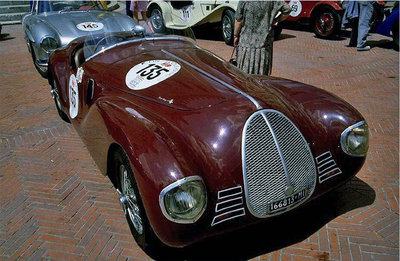Difference between revisions of "AAC 815"
m (Auto Avio Costruzioni 815 moved to AAC 815) |
m |
||
| Line 23: | Line 23: | ||
|Body style || 2-seat [[barchetta]] | |Body style || 2-seat [[barchetta]] | ||
|} | |} | ||
| − | + | [[Image:AAC Tipo 815.jpg|thumb|380px|left]] | |
Revision as of 12:46, 6 December 2008

| |
| Auto Avio Costruzioni 815 | |
|---|---|
| Manufacturer | Auto Avio Costruzioni |
| Production | 1940 2 produced |
| Successor | Ferrari 125 S |
| Class | Sports car |
| Engine | 1.5 L (1496 cc) SOHC I8 |
| Wheelbase | 2420 mm (95 in) |
| Weight | 625 kg (1375 lb) |
| Body style | 2-seat barchetta |
The Auto Avio Costruzioni 815 was the first Ferrari car that was fully designed and built by Enzo Ferrari. Bound by contracts after leaving Alfa Romeo, however, Ferrari was not allowed to call this car a Ferrari. Instead he set up shop under the name AAC (Auto Avio Costruzioni), and strictly speaking the car was named AAC tipo 815. It was named this because it had an eight cylinder, 1.5 L engine. It showed promise at the Mille Miglia of 1940, with the two 815s built run by Lotario Rangoni/Enrico Nardi and Alberto Ascari/Giuseppe Minozzi, but both broke down and did not finish. Ascari's car was sold to racer Enrico Beltrachini and it reappeared after WW II, but Rangoni's was scrapped in 1958 after being passed on to Lotario's brother, Rolando. The only remaining 815 today is chassis 815/021 and is held in the Righini collection owned by Mario Righini in Italy.
The AAC 815 was built primarily of Fiat components, specifically scavenging the 1.5 L (1496 cc) straight-8 engine and chassis from the 508 C Balilla 1100. The bodywork was done by Carrozzeria Touring, who would work extensively with Ferrari in the next decade, and was done in long, flowing forms with integrated wings. The engine was high-tech for the time, with a single overhead camshaft, two valves per cylinder, and a semi-dry sump lubrication system. A four-speed manual transmission was integral to the engine block. Four Weber 30DR2 carburettors were specified for a total output of 72 hp (54 kW) at 5500 rpm, allowing the light 625 kg (1378 lb) car to hit nearly 170 km/h (106 mph).
External Links

